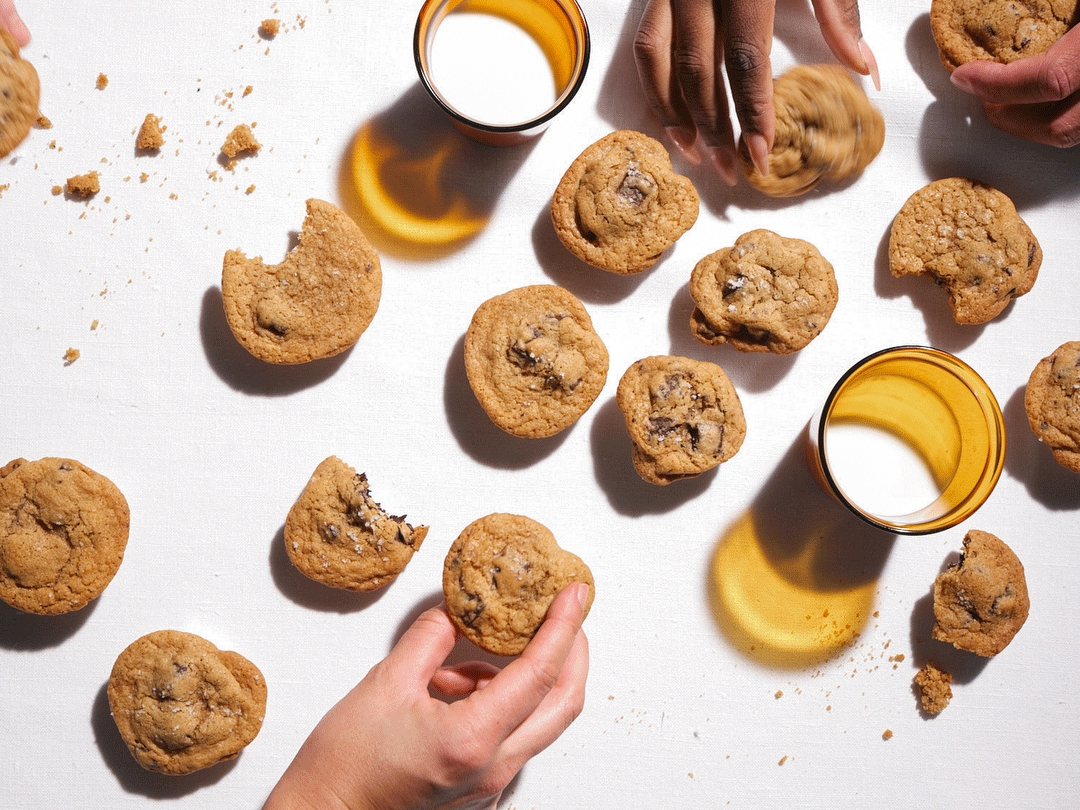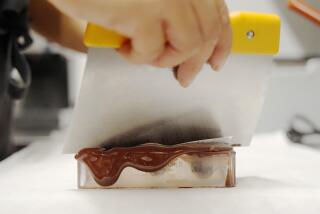Mastering the Art of Tempering Chocolate : Some Suggestions for Using Double Boiler and Microwave Oven Methods
- Share via
Tempering crystallizes the cocoa butter in chocolate into a very fine, homogeneous mass. This process ensures that chocolate will have a high gloss, even color and texture and a crisp snap when broken.
Since most chocolate is in this condition when purchased, cooks needn’t be concerned unless they melt the chocolate for dipping or molding. This breaks the temper, and the finished products will “bloom”--be dull and grainy, with a whitish film--unless the temper is restored.
The process of tempering chocolate involves heating it to 110 to 120 degrees, then cooling it to an optimum temperature for dipping or molding, which varies depending on the type of chocolate, as noted below:
Bittersweet and semisweet--86 to 91 degrees.
Milk--84 to 86 degrees.
White--84 to 86 degrees.
A chocolate thermometer that measures temperatures from about 50 to 140 degrees in one-degree increments is a wise investment for anyone serious about tempering chocolate. They are available at cooking and baking specialty shops.
The Times’ Test Kitchen experimented with tempering chocolate using a double boiler and a microwave oven. Both accomplished the same result, but the microwave oven proved to be the easier of the two methods. Using a double boiler required keeping close tabs on the temperature of the water as well as the chocolate. With the microwave oven, the power setting was placed at 50% and only the temperature of the chocolate needed to be checked.
A standard heating pad, turned to the lowest setting and covered with plastic wrap for protection, worked well for holding the tempered chocolate during dipping.
Both of the following methods require 1 pounds chocolate. At least one-quarter pound must already be in good temper and should be in a solid chunk. This is used for “seeding,” stabilizing the butter fat crystals. Coarsely chop the remaining one pound and divide in two (eight-ounce) batches.
Double Boiler Method
Place eight ounces of chopped chocolate in the top of a double boiler. Fill the bottom with enough 125-degree water to touch the bottom and sides of the top half. Retain the water at this temperature during melting.
Let the chocolate stand a few minutes until it begins to melt. Then stir and gradually add the remaining eight ounces of chopped chocolate until all the chocolate is melted. Dark chocolate should be stirred frequently, milk chocolate almost constantly and white chocolate continuously to ensure the crystals melt completely and evenly.
Heat the melted chocolate until it reaches 110 to 120 degrees. Remove the top of the double boiler and dry the outside of the pan. Transfer the chocolate to a one-quart bowl. Add a quarter-pound solid piece of chocolate and stir slowly and continuously until the temperature drops to the optimum dipping temperature.
Remove the piece of chocolate (this is now out of temper). Place the bowl on a heating pad wrapped in plastic with the temperature set at low. The chocolate is ready for dipping.
Microwave Oven Method
Place eight ounces of chopped chocolate in a two-quart microwave-safe bowl. Microwave at 50% power until melted, 90 seconds to three minutes. Check milk or white chocolate after 90 seconds.
Stir chocolate, making sure it is completely melted, then add remaining eight ounces chopped chocolate. Microwave at 50% power another 90 seconds to 3 minutes, gently stirring until melted.
Check temperature. If chocolate has not reached 110 to 120 degrees, microwave at 10% power five to 15 seconds until it reaches that level. Transfer chocolate to one-quart bowl. Add a quarter-pound solid piece of chocolate and stir slowly and continuously until the temperature drops to the optimum dipping temperature.
Remove the piece of chocolate (this is now out of temper). Place the bowl on a heating pad wrapped in plastic with the temperature set at low. The chocolate is ready for dipping.
Stir regularly as the chocolate is used. If it loses fluidity, microwave at 10% power five to 10 seconds, but do not heat above 91 degrees.
--Adapted from the International Assn. of Cooking Professionals Research Report of October 1986.


